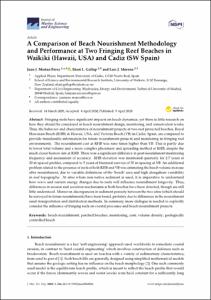| dc.contributor.author | Muñoz-Perez, Juan J. | |
| dc.contributor.author | Gallop, Shari L. | |
| dc.contributor.author | Moreno, Luis J. | |
| dc.coverage.spatial | Cadiz Bay | en_US |
| dc.coverage.spatial | Hawaii | en_US |
| dc.date.accessioned | 2023-06-06T18:14:58Z | |
| dc.date.available | 2023-06-06T18:14:58Z | |
| dc.date.issued | 2020 | |
| dc.identifier.citation | Muñoz-Perez, J. J., Gallop, S. L.and Moreno, L. J. (2020) A Comparison of Beach Nourishment Methodology and Performance at Two Fringing Reef Beaches in Waikiki (Hawaii, USA) and Cadiz (SW Spain). Journal of Marine Science and Engineering, 8:266, 12pp. DOI: https://doi.org/10.3390/jmse8040266 | en_US |
| dc.identifier.uri | https://repository.oceanbestpractices.org/handle/11329/2254 | |
| dc.description.abstract | Fringing reefs have significant impacts on beach dynamics, yet there is little research on how they should be considered in beach nourishment design, monitoring, and conservation works. Thus, the behavior and characteristics of nourishment projects at two reef protected beaches, Royal Hawaiian Beach (RHB) in Hawaii, USA, and Victoria Beach (VB) in Cadiz, Spain, are compared to provide transferable information for future nourishment projects and monitoring in fringing reef environments. The nourishment cost at RHB was nine times higher than VB. This is partly due to lower total volume and a more complex placement and spreading method at RHB, despite the much closer borrow site at RHB. There was a significant difference in post-nourishment monitoring frequency and assessment of accuracy. RHB elevation was monitored quarterly for 2.7 years at 30 m-spaced profiles, compared to 5 years of biannual surveys of 50 m-spacing at VB. An additional problem related to the presence of reefs at both RHB and VB was estimating the beach volume increase after nourishment, due to variable definitions of the ‘beach’ area and high alongshore variability in reef topography. At sites where non-native sediment is used, it is imperative to understand how wave and current energy changes due to reefs will influence nourishment longevity. Thus, differences in erosion and accretion mechanisms at both beaches have been detected, though are still little understood. Moreover, discrepancies in sediment porosity between the two sites (which should be surveyed in future nourishments) have been found, probably due to differences in the nourishment sand transportation and distribution methods. In summary, more dialogue is needed to explicitly consider the influence of fringing reefs on coastal processes and beach nourishment projects. | en_US |
| dc.language.iso | en | en_US |
| dc.rights | Attribution 4.0 International | * |
| dc.rights.uri | http://creativecommons.org/licenses/by/4.0/ | * |
| dc.subject.other | Beach nourishment | en_US |
| dc.subject.other | Fringing reefs | en_US |
| dc.subject.other | Perched beaches | en_US |
| dc.subject.other | Geologically controlled beach | en_US |
| dc.title | A Comparison of Beach Nourishment Methodology and Performance at Two Fringing Reef Beaches in Waikiki (Hawaii, USA) and Cadiz (SW Spain). | en_US |
| dc.type | Journal Contribution | en_US |
| dc.description.refereed | Refereed | en_US |
| dc.format.pagerange | 12pp. | en_US |
| dc.identifier.doi | https://doi.org/10.3390/jmse8040266 | |
| dc.subject.parameterDiscipline | Sedimentation and erosion processes | en_US |
| dc.bibliographicCitation.title | Journal of Marine Science and Engineering | en_US |
| dc.bibliographicCitation.volume | 8 | en_US |
| dc.bibliographicCitation.issue | Article 266 | en_US |
| dc.description.sdg | 14.2 | en_US |
| dc.description.sensors | Leica TC407 total station | en_US |
| dc.description.methodologyType | Reports with methodological relevance | en_US |
| obps.contact.contactname | Juan J. Muñoz-Perez | |
| obps.contact.contactemail | juanjose.munoz@uca.es | |
| obps.resourceurl.publisher | https://www.mdpi.com/2077-1312/8/4/266 | |
 Repository of community practices in Ocean Research, Applications and Data/Information Management
Repository of community practices in Ocean Research, Applications and Data/Information Management

